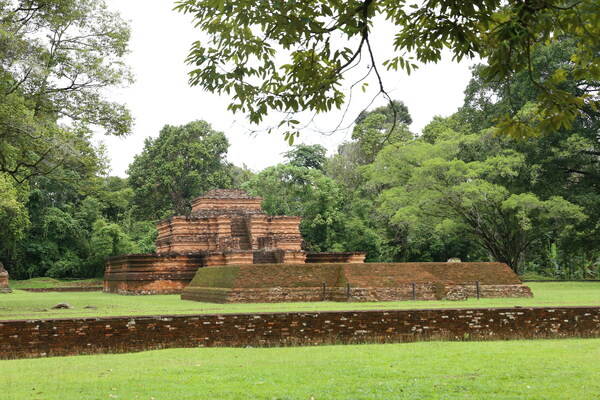JAMBI, Indonesia, Feb. 8, 2024 /PRNewswire/ -- In a remarkable chapter of Indonesia's educational and spiritual history, the journey of the esteemed Buddhist master Atisha to Muarajambi Temple marks a pivotal moment that underscores the region's significance as a nexus of Buddhist learning and practice. Over a millennium ago, Atisha embarked on a sea voyage to Sumatra, drawn by the teachings of Serlingpa, a renowned 10th-century master at Muarajambi. His journey, filled with natural adversities which he overcame through meditation on love and compassion, epitomizes the unwavering commitment to spiritual growth and the pursuit of bodhichitta teachings (a central concept in Mahayana Buddhism, representing the mind that strives toward awakening, empathy, and compassion for the benefit of all sentient beings).
Muarajambi, nestled along the Batanghari River, flourished as a vital center of Buddhist scholars within the Srivijaya empire, attracting luminaries and scholars across Asia, including Atisha who spent 12 years in deep study under Serlingpa. This period not only enriched Atisha's spiritual journey but also laid the foundation for his profound impact on Buddhism in Tibet and beyond. The legacy of Muarajambi as a cradle of Buddhist learning and its role in facilitating the cross-cultural exchange of Buddhist traditions highlight the interconnectedness of Buddhist communities and the enduring significance of this historical site.
Many are unaware that the Muarajambi Temple, standing since the era of Sriwijaya's glory, is a Buddhist cultural heritage complex spanning almost 4000 thousand hectares, making it the largest in Southeast Asia. This site reveals the importance of historical and cultural values that have persisted for centuries, showcasing the richness and depth of spiritual and educational traditions in this region.
Fitra Arda, The Secretary of the Directorate General of Culture at the Indonesian Ministry of Education, Culture, Research, and Technology, encountered at the Muarajambi Cultural Heritage (03/02), explains about its role, "Muarajambi is not only rich in history but also serves as tangible evidence of the creation of civilization, education, and important innovations in the past. The design and layout of the Muarajambi complex bear a striking resemblance to those of Nalanda, a major learning center in India, indicating that Muarajambi once served as a significant center for Buddhist learning and spiritual practice."
The Muarajambi Temple Complex spans approximately 12 square kilometers and stretches over 7 kilometers along the Batanghari River's path. The site is dotted with ancient moats or canals, water storage ponds, and mounds featuring ancient brick structures. This complex is also home to valuable artifacts such as Prajnaparamita statues, dwarapala and gajahsimha, showcasing the site's cultural and religious richness. These findings not only highlight the spiritual significance of the area but also its role as a vibrant center of learning and religious practice, setting the stage for further insights into its historical and archaeological importance as shared by Agus Widiatmoko, the head of the Cultural Heritage Preservation Agency in Jambi.
Widiatmoko further explains that archaeological excavations and carbon dating analysis at Muarajambi, including at Candi Kedaton (one of the temples at the compounds), have revealed that the temple complex was once actively utilized from. The discovery of inscriptions, and relic fragments, underscores Muarajambi's significance as a center of learning. He highlighted, "This site not only possesses high historical and archaeological value but also continues to serve as a spiritual gathering point for Buddhists."
Muarajambi Temple Revitalization to Restore Its Essence as an Educational and Spiritual Destination
The Indonesian Heritage Agency (IHA), operating under the Ministry of Education, Culture, Research, and Technology of the Republic of Indonesia, has announced the commencement of revitalization efforts for the Muarajambi Temple Complex. This initiative is part of IHA's broader mission to restore the site's role as a key educational and spiritual hub for the community.
The head of Indonesian Heritage Agency, Ahmad Mahendra, stated, "Our goal is to rejuvenate Muarajambi's historical function as a center for spiritual learning and education, thereby affirming its significance as a global heritage site." This endeavor is in line with the government's dedication to fostering religious harmony and cross-cultural exchange by preserving and celebrating the area's rich spiritual traditions.
The comprehensive evidence from Muarajambi, spanning architecture, inscriptions, to archaeological discoveries, reveals its crucial role in the history of civilization, serving as a silent witness to innovation, cultural exchange, and the spread of Buddhism in the region. The existence and function of Muarajambi as a center for worship and education underline its significance in the annals of civilization and innovation. This rich historical tapestry emphasizes the importance of its revitalization, not just as a restoration of physical structures but as a rejuvenation of the living, breathing cultural and spiritual legacy that Muarajambi represents.
"Through these efforts, the Indonesian Heritage Agency aims to not only preserve this invaluable heritage for future generations but also to rekindle the profound spiritual and educational values it embodies, thereby continuing its legacy as a beacon of learning, faith, and cultural exchange in the modern world," said Mahendra in closing.
Link to photo Muarajambi.
About the National Cultural Heritage Area of Muarajamb Temple
The National Cultural Heritage Area of Muarajambi Temple, located along the Batanghari River in Jambi Province, Sumatra, Indonesia, is one of the oldest and largest Buddhist Cultural Heritage Areas in Southeast Asia. Dating from the 7th to the 13th century, this complex is closely linked to the history of the Ancient Malay Kingdom.
The area covers 3,981 hectares, featuring 11 main temples, with an estimated 82 ruins still buried under mounds. It stretches 7.5 kilometers from west to east along the Batanghari River, the longest river in Sumatra.
The National Cultural Heritage Area of Muarajambi Temple is not only vital for understanding the history and development of Buddhism in Indonesia but also the social and political dynamics in ancient Sumatra. Today, as a tourist and research site, preservation and revitalization efforts are conducted by the Indonesian Heritage Agency to maintain this historical heritage for future generations, making it a valuable source of knowledge about Indonesia's past.
About the Indonesian Heritage Agency
The Indonesian Heritage Agency (IHA) is a public service agency under the Ministry of Education, Culture, Research, and Technology of the Republic of Indonesia, currently responsible for managing 17 museums, 1 gallery, and 34 national cultural heritage sites in Indonesia. Established in 2022 and officially becoming a public service agency on September 1, 2023, IHA aims to be a collaborative institution that encourages creativity, social change, and the development of a cultured society.
IHA prioritizes service improvement based on protection as its main priority. By embracing creativity and fostering an inclusive spirit of collaboration, IHA collectively contributes to deepening appreciation for Indonesia's diverse cultural heritage.
Link to photo.
Media contact: komunikasikemitraan.mcb@gmail.com












